One of the things we’ve been most excited about in the vehicle prepping market over the last few years is how modern battery technology enabled a new category of personal, portable chargers for jumping a dead battery and other power-hungry vehicle fixes.
I’m a big believer in buying high-quality devices that do one thing well — many “survival products” that claim to do lots of various things are usually poor at all of them. Which is why I was skeptical when my wife gave me a Halo Bolt Air for Christmas.
It wasn’t long before the Halo Bolt Air saved my bacon and I’ve really warmed up to the product. It’s not best-in-class at anything, but it does the job in a convenient package. I decided that this would actually be a great device for someone with not a lot of interior space in their car. I thought back to a weekend trip to Atlanta riding in the backseat of a Volkswagen Jetta. Or our Honda Pilot, which is a lot less spacious with three kids strapped in the second row.
Summary:
- Costs $130 on average (has been on sale for $100), 2.53 pounds, dimensions in storage bag: 12”x6”x2”
- All of the functions work. I used it to successfully jump-start a truck and inflate a tire.
- The air compressor works quickly to refill low tires, but it’s a bit of a drain on the battery at 3% per 5 PSI loaded. And the built-in pressure gauge is usually off by 5 PSI or so.
- The 8” jumper cables are shorter than I’d like, but that’s also pretty common for this category of portable jump starter.
- There are two 5V 2.4A USB-A ports for charging phones, but this is not a replacement for a proper portable battery bank.
- The built-in light is a bonus/backup that would be most useful as a road beacon to warn off other drivers. It’s not a replacement for a purpose-built flashlight.
Jump starting with the Halo Bolt Air
Battery-powered jump starters are probably the greatest roadside emergency innovation since Fix-A-Flat. It used to be when your car battery died, you had to find another driver to give you a jump start from their battery. And if you didn’t have your own jumper cables, you had to hope you could flag someone down who had a set.
I still recommend keeping jumper cables in your vehicle, but a jump starter is much easier and safer to use. Connect the starter’s clamps to the positive and negative terminals of your battery, press a button, and start your car. No other car is required, and most jump starters, like the Halo Bolt Air, have reverse polarity protection to alert you if you get the clamps backward. Jump starters are convenient and practically idiot-proof.
I got to put the Halo Bolt Air’s jump starter to the test a couple of weeks ago when the temperature dropped to the single-digits overnight and I walked out to a dead battery in my Dodge Ram 1500 (which probably means I need to replace the battery). I have another jump starter in my truck, but I decided it was a good time to test the Halo Bolt Air.
The Halo Bolt Air comes with a drawstring bag that holds the Bolt Air and its various included accessories. One of those accessories is a pair of jumper cable clamps that plug into the front of the unit. A nice touch is that the bag features instructions for both the jump starter and air compressor, though both are pretty simple.
Once I dug the jumper cables out and plugged them in, I had to figure out how to get them on the battery. The cables are short — only about 8 inches long — so it took a bit of finagling to get the large Halo Bolt Air in position without getting in the way. Once I got that settled, I pressed the jump start button on the front of the unit and the truck cranked right up.
Checking the Halo Bolt Air’s front panel, the jump start hadn’t consumed any of the battery, and it was still 100%.
Inflating tires with the Halo Bolt Air
The air compressor is where the Halo Bolt Air falls flat. First, let’s talk about the good. The Halo Bolt Air comes with a small drawstring bag full of various needles and adapters. Given that the Halo Bolt Air’s compressor is battery-powered, it’d be a good device to take camping to inflate small rafts and balls.
The Halo Bolt Air’s short air hose is built in. It’s only 9 inches long, but it includes a 22.5-inch screw-on extender for a total of 31.5 inches. Unfortunately, while the built-in hose has a secure screw-on chuck, the extension has a clamp-on chuck. And a pretty hard one to close at that.
Once the Halo Bolt Air is clamped onto a valve stem, the display shows the current inflation level. Unfortunately, I found that it reads about 5 PSI lower than my trusty tire gauge, so you’ll still want to keep a tire gauge in your kit to have two points of reference.
You can set the desired pressure on the front of the unit, and the Halo Bolt Air will stop inflating when it hits that pressure. I had a tire that was around 5 PSI under its recommended 35 PSI pressure. I set the Halo Bolt Air to 35 PSI and it quickly inflated and cut off. Unfortunately, it had only inflated to 30 PSI, so I set the Halo Bolt Air to 40 PSI and tried again, which got me to 35 PSI.
I was glad it was consistently inaccurate, but then I inflated another tire hovering around 30 PSI and that time the Halo Bolt Air actually inflated it to 40 PSI. I’m not sure if the one tire was a fluke or what, but in any case, I recommend double-checking the PSI.
The Halo Bolt Air inflated the tire quickly, but at a pretty steep cost to battery life at around 3% for every 5 PSI. I decided to try connecting it to the cigarette lighter charger while it inflated, but the cable is way too short to let the Halo Bolt Air reach the tire. So I charged it after inflating, and the car adapter only charges it about 2% every 10 minutes.
So if you inflate four tires by 5 PSI, each taking 3% of the battery, you’ll be down to 88% by the time you’re done (assuming you started at 100%) and it’ll take one hour to charge the battery back to 100%.
The Halo Bolt Air won’t replace my trusty VIAIR 84P, but it’ll do in a pinch, as long as you don’t have to inflate more tires than the battery can manage.
Charging devices and using the floodlight
There isn’t a lot to say about using the Halo Bolt Air as an emergency charger. It features two USB-A ports on the front, each putting out 5 volts at 2.4 amps, which is enough to slowly charge phones but won’t be enough for tablet computers or fast charging. You wouldn’t want it as a primary charger, but it’s just fine for emergency phone charging. I can’t complain about the number of included cables and adapters. It also comes with both an AC wall charger and a cigarette lighter charger for the car.
You can press the Unit button on the front to see the current battery level. With a large 58,830 mWh battery, it should be able to power a phone for a long time. The battery seems to hold up well, at least in cold weather. After sitting in my cold truck for a couple of weeks, the power had dropped from 100% to 99%. Hot weather might be a different story.
The floodlight on the side of the unit is a nice thing to have, but I wouldn’t forgo a flashlight. It’s bright enough, but the problem is aiming the light will probably conflict with moving the unit to where you need it. There are three light settings: white light, red light, and flashing red light. The third is probably the most useful since you can set the Halo Bolt Air as an emergency beacon at night.
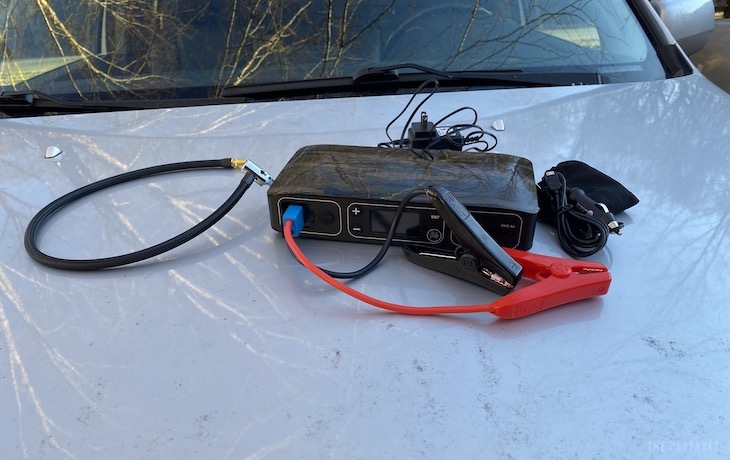
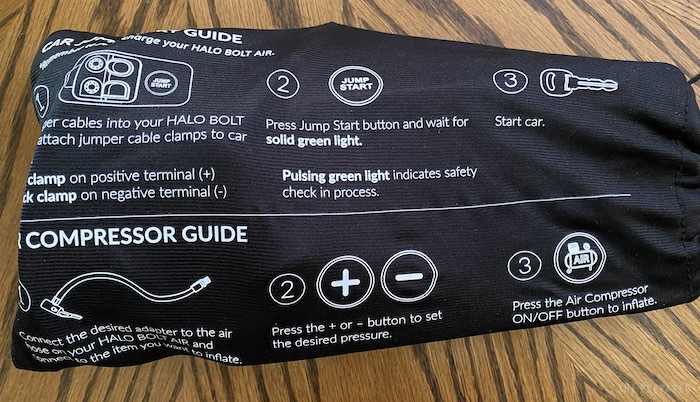
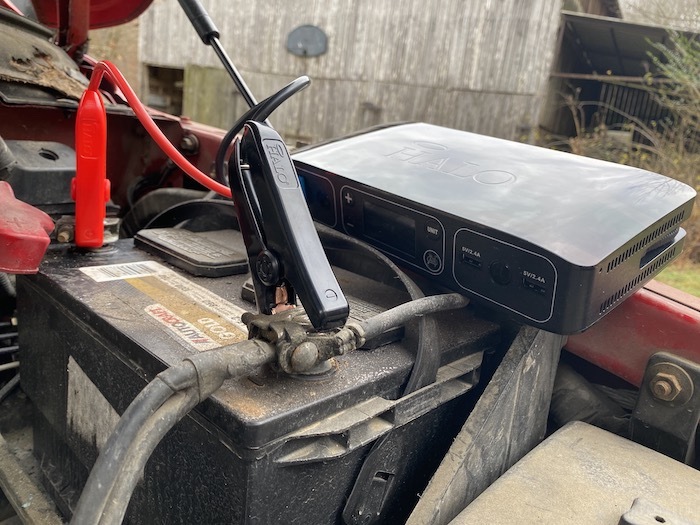
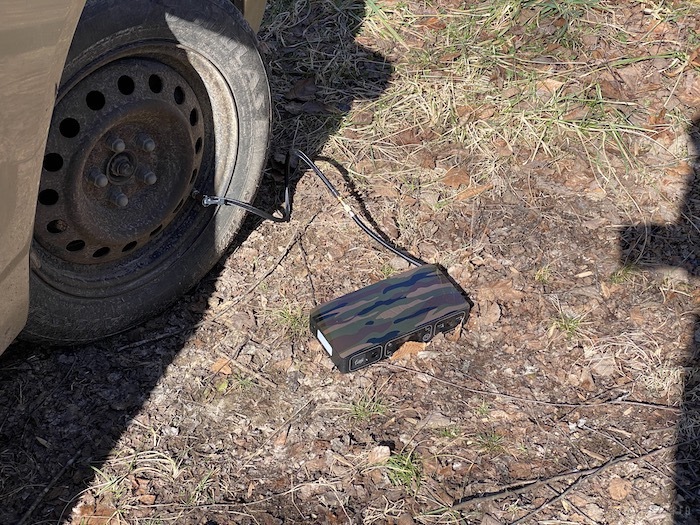
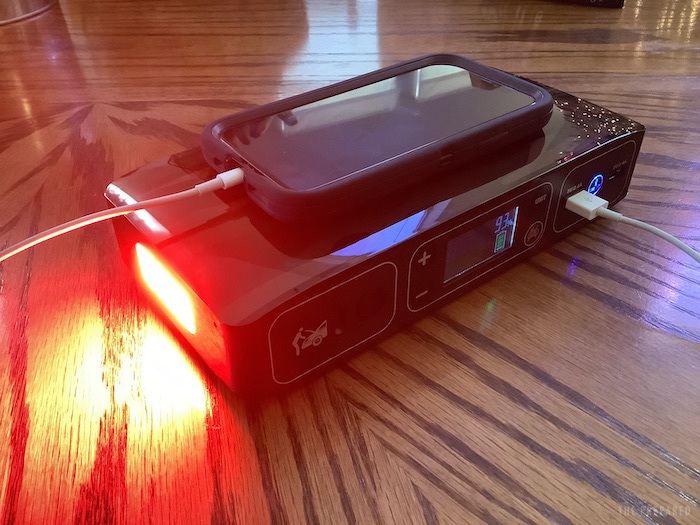
You are reporting the comment """ by on